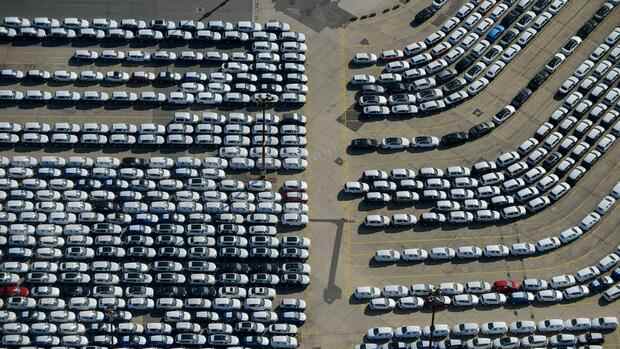The decrease is due to vehicles with internal combustion engines. In the case of purely electric vehicles, on the other hand, strong growth was again recorded.
(Photo: imago images / Joerg Boethling)
Berlin Delivery bottlenecks caused German car exports to collapse in the third quarter. From July to September, passenger cars worth 23.1 billion euros were exported from Germany, 17.2 percent less than in the same period last year, as the Federal Statistical Office announced on Monday.
Imports even fell by 29.8 percent to 11.2 billion euros. “The reasons for this development are likely to be the lack of chips in the automotive industry and other delivery bottlenecks,” it said.
The decrease is due to vehicles with internal combustion engines. In the case of purely electric vehicles, on the other hand, there was again strong growth: from July to September, 69,800 purely electric vehicles with a value of 2.9 billion euros were exported. That was an increase in value of more than a quarter (plus 26.9 percent) compared to the same period of the previous year.
The increase in imports was even more pronounced: with 59,700 electric vehicles for 1.7 billion euros, the value rose by more than half (plus 58.4 percent).
Top jobs of the day
Find the best jobs now and
be notified by email.
Cars with internal combustion engines still make up the majority of passenger car exports and imports, but the trend was sharply downward: In the three most important displacement classes with internal combustion engines, a total of 254,000 cars with a value of 8.5 billion euros were exported in the third quarter, which is one A decrease of 44.8 percent. 213,900 cars with a value of 4.3 billion euros were imported, a decrease of 49.8 percent.
Most of the cars were delivered to the United States during the summer months. Cars worth 3.2 billion euros went there. Other important customers were China (2.9 billion euros) and Great Britain (2.0 billion euros).
In terms of imports, the United States was also Germany’s most important trading partner in the automobile market. From there, cars to the value of 1.6 billion euros were imported. In the ranking of the most important importing countries, Spain (1.2 billion euros) and the Czech Republic (0.9 billion euros) follow.
Most of the all-electric cars exported from Germany went to the UK. The second most important customer was Norway, followed by the USA. Electric vehicles imported into Germany were mainly from the United States. This is where South Korea and the Czech Republic came in.
More: China is the growth engine for Daimler – also in the coming year
